Building a collection of Bf 109Gs
by Peter Ibes
photos by Frits Snijder
This article was first published in ‘Modelbouw in Plastic’ – a magazine of IPMS Netherlands .
Used with permission of the Editor.
I started my series of 1/72nd foreign Gustavs many years ago, as I was intrigued by their unfamiliar markings and the often twilit history of their air forces. For all these models I used the Me 109 G and K from Heller-Encore. Some fellow modellers might consider them out of date, having no engraved panel lines and such. But due to the soft plastic they are made of and their interchangeable parts, the whole range from the Me 109 F to the K-4 can be build using these kits. Some of my Gustavs have been altered or upgraded, which included transplanting tailplanes and swapping wheels and drop tanks for resin examples. Nevertheless, I think Heller really did manage to capture the typical shape of this aeroplane.
The Messerschmitt 109 was the backbone of the Luftwaffe fighter force, from the first day of World War II to the last. All in all some 35.000 were built, more than any other plane to this day. Of those, some 23.000 were of the ”G” model. These were not only delivered to the German Luftwaffe, but also to the air forces of numerous Axis allies as well. Even the neutral Switzerland received some examples of this fighter. This gives the modeller a wide choice of uncommon markings to build a ‘special’ Gustav.
Finland, Ilmavoimat
Finland had been at war with the Soviet Union since the winter of 1939-1940. Ordered by Stalin, the Red Army had invaded Finland to put an end to the countrys independence of 1917. But due to the bad organisation of the Russian army and by using hit-and-run tactics, the Fins had managed to stop the Russian onslaught.
When Germany invaded Russia in 1941, the Fins seized the opportunity and turned to the Germans for help.
From 1942 on, the Ilmavoimat (Finnish Air Force) received several Me 109 G-2s. With these modern aircraft they were finally able to retire their ageing Fokker D XXIs and Fiat G-50s. In addition the G-2s, Germany supplied Finland with several G-6s, G-8s and G-14s, which soldiered on in Finnish service until the 1950s.
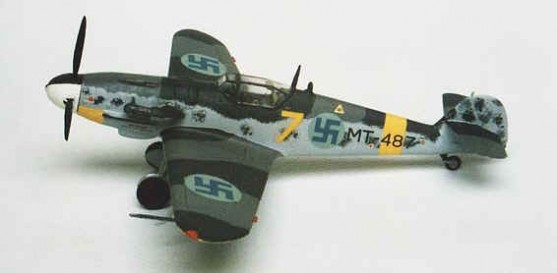
My model represents Me 109 G-6, 2/HLvLv30, Finland 1944.
Decals came from Inscale 72, sheet no. AC 002.
Italy, Regia Aeronautica
In 1943, after the last Axis forces had been driven from Tunisia, Italy found itself under great pressure as the next allied step was clearly the invasion of Sicily. The Italian aviation industry was by far not able to supply the Regia Aeronautica with the number of aircraft needed to stave off this eminent invasion. The Regia Aeronautica therefore turned to their German counterpart for help.
In 1943 Germany delivered 113 Me 109 Fs, G-2s, G-4s and G-6s for the defence of Sicily. These were gathered in the 150o Gruppo Autonomo Caccia Terrestre, consisting of the 363a, 364a and 365a Squadrilia, as well as in the 3o Gruppo, with the 153a, 154a and 155a Squadrilia. After many training accidents the aircraft were used against the American and British air forces, but there was little the Italian pilots could do against the Allied air supremacy.
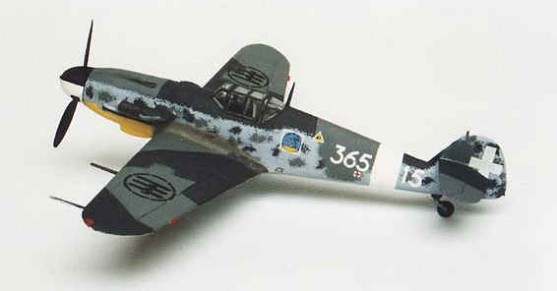
Me 109 G-6, 365a Squadrilia, Sicily, June 1943. Decals from Tauro, sheets no. 72-522 (squadron emblems and numerals) and 72-520 (roundels and white crosses).
Italy, Aviazione Nazionale Repubblicana
After the surrender of Italy, on 8th September, 1943, the Germans quickly seized all Italian territory not in Allied hands. They also managed to free Benito Mussolini from his mountainous captivity at Gran Sasso. On 23th September, 1943, the fascist Repubblica Sociale Italiana was proclaimed in Northern Italy, with Mussolini as its leader.
Using personnel from the former Regia Aeronautica, a new air force was set up to fight alongside the Germans. At first instance this new air force, the Aviazione Nazionale Repubblicana (ANR), flew mainly Macchi 205s and Fiat G-55s, as the factories where these types were build were firmly in Axis hands in Northern Italy. But, after heavy raids by the American 15th Air force, the production of Fiats and Macchis broke down and from April 1944 on, the ANR received 183 Me 109 G-6s, G-14s, G-10s and even some K-4s.
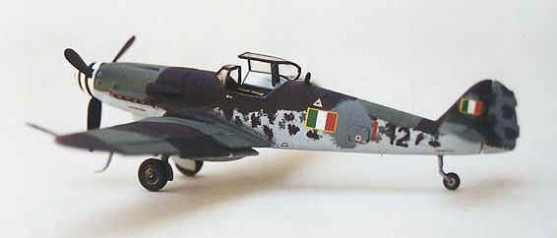
Me 109 G-10/R3 (W.Nr. 490266), M.llo Dino Forlani, 1a Sq., 1o Gruppo Caccia, Lonate Pozzolo, Northern Italy, March 1945. Decals from Tauro, sheet no. 72-528 and 72-517.
Freies Rußland (Free Russia)
For many Russians the German invasion of the country meant a liberation from bolshewism. This fact was used by the Germans to set up an ‘independent’ Russian army, under command of general Vlasov. At the very end of the hostilities this army was extended with a fighter unit, with the designation Jagdstaffel 5 Freies Rußland. Although very little is known of this fighter unit, it is said to have flown some fifteen Me 109 G-10s.
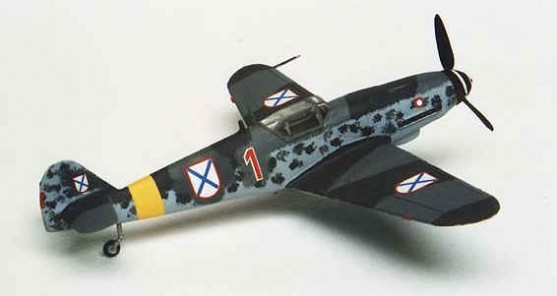
Me 109 G-10, Oberst Kasalov, Jagdstaffel 5. Decals from Aeromaster, sheet no. 72-034, ‘Augsburg Eagles’ part two.
Hungary, Magyar Királyi Honvéd Légierö
As one of the few Axis countries, Hungary fought alongside the Germans until the bitter end of World War II. When Germany invaded Russia, they were joined by Hungarian forces. Although the Hungarians were still negotiating the delivery of Heinkel 112 Bs, they only had Italian build Reggiane Re 2000 available for the fight against the Red Air Force. In 1942, with the growing Russian resistance, the Royal Hungarian Air force (Magyar Királyi Honvéd Légierö) had to be strengthened. The Germans therefore started to deliver Me 109 Fs and Gs, and allowed the Hungarians to license-build the type.
The Hungarian Gustavs continued to fight on against the Russians, even after the whole of their country had been seized. The last G-10 finally surrendered to American forces in Klagenfurt in Austria in May 1945.
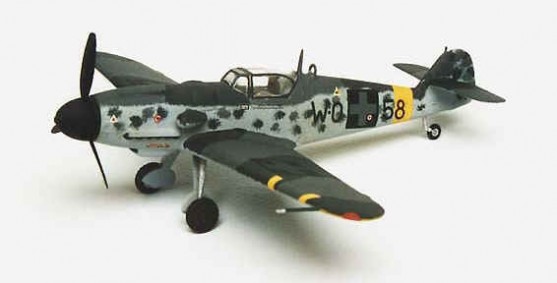
Me 109 G-14, Lt. Antal Szebeni, 101/4 (Puma) squadron, Hungary 1944. Modified decals from Tally Ho sheet 7009, Hungarian Fw 190 As.
Continuing through my 1/72ns scale collection of foreign Bf 109s, here are the remaining Gustavs is esoteric markings. All models are all based on the old but nice Heller/Encore kit.
Romania, Fortele Ariene Regale Româna
Romania was an important ally for Germany in the fight against the Soviet Union. The country was of vital importance for the Axis war effort, due to the oil fields in the country.
The Romanian Royal Air force, Fortele Ariene Regale Româna, had been a loyal customer of the German aviation industry. German types in use included the Me 109 E and the Heinkel He 112 B. After the famous Ploesti raid against the Romanian oil fields by the American 15th Air Force, the Romanians urgently received a large number of Me 109 G-2s and G-4s, later followed by G-6s, which replaced their ageing force of IAR 80s.
In 1944, when the Red Army entered Romanian territory, the country changed sides and from then on the remaining Gustavs were used against the retreating German forces.
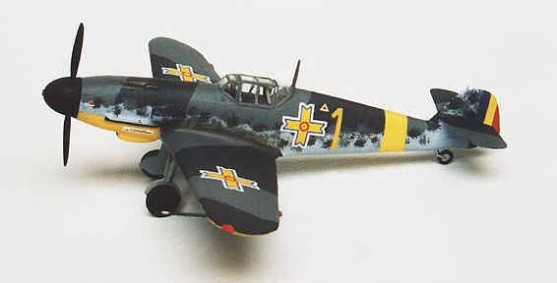
Me 109 G-4, Corpul 1 Aerian, Romania 1944. Decals from Aeromaster ‘Foreign Hurricanes’ (crosses) and Aviation Usk sheet no. 7118 (yellow 1).
Bulgaria
Among the Axis countries Bulgaria was the only country that did not declare war on the Soviet Union. Probably because they thought the stakes would be less high, the Bulgarians had only declared war on the western allies. In order to persuade them to join the fight against Russia, the Germans supplied them with large amounts of war material, including Arado 96s, Me 109 Es and French Dewoitine 520s. Only after the Ploesti air raids were the Bulgarians supplied with Me 109 Gs, as the Americans had to fly across Bulgaria to get to Romanian oil fields.
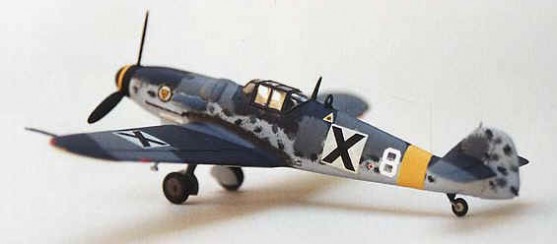
Me 109 G-6, 6th Fighter Regiment, Bulgaria, April 1944. Decals from Aeromaster, sheet no. 72-034, ‘Augsburg Eagles’ part two.
Slovakia, Slovenské Vzdušné Zbrany
After the occupation of western Czechoslovakia in 1938, Slovakia became independent. Yet in reality the new country was ruled by a puppet government, with the Germans holding the strings. This and a border conflict with the Soviet Union, led to the Slovakian air force to take part in Operation Barbarossa.
The Slovak fighter force was only small and comprised mostly of ageing Czech types and a few Me 109 Es. These were finally supplanted with Me 109 Gs in 1943, in order to face the growing strength of the Russian air force.
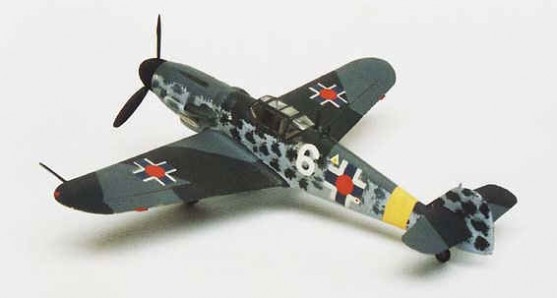
Me 109 G-6, 14th Slovakian Fighter Squadron, Russia 1943. The decals are made from standard Luftwaffe crosses, with the black over painted with blue. The red centre dots were punched from a red decal sheet. The white 6 came from an Almark sheet of Luftwaffe numerals.
Croatia, Hrvatsko Bojno Zrakoplovstro
After the occupation of Yugoslavia, the Germans set up an independent Croatian state. In exchange Croatian ‘volunteers’ fought alongside the Germans on the Eastern Front. They were further fighting on their own territory against (mainly) Serbian partisans.
At first the Croatian fighters on the Eastern Front were grouped in 15.(Kroat.)/JG 52, under command of Luftflotte 4. In 1942 the first Me 109 G-2s were delivered to this Croatian Legion, later replaced by Me 109 G-6s and G-10’s. In the mean time the designation of the unit had changed to 1. Kroatische Jagdstaffel. This unit retreated with the Germans from Russia, until they reached Eichwalde in Eastern Prussia in early 1945. They were then transferred to Klagenfurt in Austria, hence the over painted yellow tail band. There the last Croat Gustavs surrendered to American forces in May 1945.
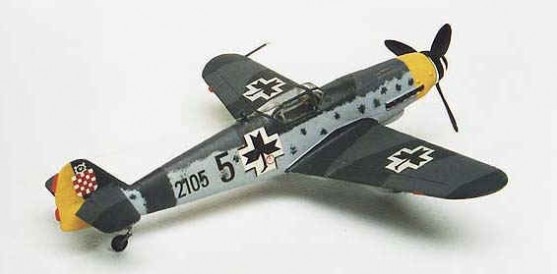
Me 109 G-10, 1.1. Kroat. JSt, Austria 1945. Decals from Blue Rider, sheet no. BR 217 Croatian Air force 1941 – 1945.
Switzerland, Flugwaffe
Messerschmitt 109 Gs in Swiss service? Wasn’t the country neutral during World War II? Yes, they were, which is why the Swiss Flugwaffe had a lot of difficulty trying to buy aircraft from either the Allies or the Axis. They finally got lucky when in 1944 a Me 110 G-4 night fighter got lost and crash-landed on the Swiss territory. This particular aircraft was carrying the latest Lichtenstein airborne radar and the German authorities were determined not to let this prize fall into the hands of Allied spies. They therefore demanded that the remains of the aircraft be destroyed under German supervision. The Swiss were able to negotiate a deal (you don’t have to learn the Swiss anything when money is concerned) and in May 1944 the Flugwaffe received 12 brand new Me 109 G-6s, augmented by two other examples that had strayed into the Swiss air space.
At first the Flugwaffe was quite happy with these modern fighters, but they soon had a lot of trouble with them due to bad craftsmanship. After an accident, where two Gustavs were lost in the Alps due to bad weather, the Me 109 Gs were retired in 1946.
References
More information on Foreign Gustavs can be found in the following literature:
- The Augsburg Eagle: a Documentary History W. Green, Jane’s Publishing Company, London, England
- ‘Messer’, the Messerschmitt 109 in the Royal Hungarian ‘Honvéd’ Air Force, OMIKK, Budapest, Hungary
- Hungarian Air Force, G. Punka, Squadron Signal Publications, Carrolton, Texas, U.S.A.
- The Messerschmitt 109 in Italian Service, 1943 – 1945, F. D’Amico and G. Valentini, Monogram Aviation Publications, Boylston, Massachusetts, U.S.A.
- Sojusznicy Luftwaffe, J. Rajlich, Z. Stojczew and Z. Lalak, Books International, Warsaw, Poland
- Aircraft Profile no. 113: The Messerschmitt 109 G, J.R. Smith and I. Primmer, Profile Publications Ltd., Windsor, Berkshire, England
- Air War Italy 1944 -1945: The Axis Air Forces from the Liberation of Rome to the Surrender,
- N. Beale, F. D’Amico and G. Valentini, Airlife Publishing, Shrewbury, England
This article was originally published in IPMS Stockholm Magazine in October and September 2000.
